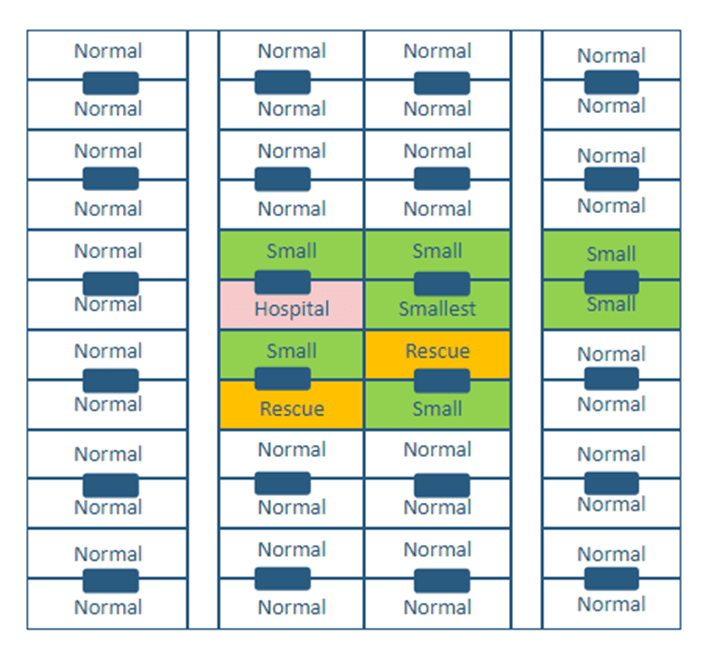Weaning is a stressful time in a pig’s life. To ensure weaned pigs get off to a good start in the nursery, they should be placed into a clean, dry, and warm environment with the correct tools and resources. Read more to learn about PIC’s recommended placement plan and how to incorporate it when receiving newly weaned pigs.
Before Pigs Arrive
First and foremost, the barn should be properly cleaned, disinfected, and inspected prior to receiving a new group. Pathogens left by the previous group can present a challenge that newly weaned pigs are poorly equipped to handle. The barn should also have ample time to dry, pigs should never be placed in a wet barn. For more information on PIC’s biosecurity guidelines, visit our BioShield manual here.
It’s easy to focus on receiving your next group of pigs and overlook simple procedures that happen during downtime between the two groups. Be sure to leave time (2-3 days) to inspect barns before arrival. A second pair of eyes can help find anything that might be overlooked: this can mean both maintenance items and cleanliness. Checking the barn to be sure it is ready the morning pigs are received leaves no time for corrections to be made.
Approximately 24 hours before pigs arrive, PIC recommends the room temperature should be set at 70°F. By pre-warming the room 24 hours before reception, the floor and other equipment in the pens will also have time to warm up, which will reduce chilling of pigs. Ensure all comfort zone tools, such as mats or brooders, are placed and functioning correctly.
Prior to arrival, review all environmental controls and settings. Ensure the day one room temperature and temperature curve are set properly. All equipment such as fans, inlets, heaters, brooders, and curtains should be clean and working correctly. Refer to PIC’s ventilation checklist in the Wean to Finish manual for a comprehensive list to walkthrough prior to receiving pigs.
Placement Plan
Implementation of a placement plan is the next step in receiving pigs into the barn. PIC recommends allocating pens into four different categories: normal, small, hospital, and rescue. By knowing the status of weaned pigs that will be received, a placement plan can be created beforehand. Groups of pigs facing a health challenge may need more empty pens or increased sorting at the start.
Individually review the placement plan for each group of pigs received. Not all barns are built the same and pigs can differ from group to group. Understanding the limitations faced at each site can help create a placement plan that fits the group of pigs being received and their environment. Pig classifications will vary in different scenarios, work with your team and herd veterinarian to determine the placement plan that best suits your situation. PIC’s sick pig identification tool can help identify those pigs that need extra attention.

Normal
The normal category will be most of the pens, approximately 80%.
Small
PIC recommends sorting out the bottom 10% – 20% of small pigs at reception to be placed together, this pen should not be used for sick pigs.
Hospital
A separate hospital pen(s) should be available for any sick or injured pigs in need of intensive care upon arrival. Place any challenged piglets immediately in hospital pens.
Rescue
Rescue pens should be left available for use in the first five days. This pen is for pigs identified from the general population that have not adapted or adjusted as quickly as the others. The rescue pen provides a chance for those pigs to recover.
By placing the small, hospital, and rescue pens toward the center of the barn, temperature variation is reduced, and it tends to be warmer. Extra comfort zone tools, such as brooders and mats, should be provided to these pens even in warmer months and might be left for longer periods of time. It’s not always possible to add in extra feeders or drinkers, by stocking small or hospital pens at 80%, there will be extra space and availability to water and feed resources for these pens. By overstocking these pens, more competition is created and can cause a bigger challenge for these animals to recover. These pens should also receive extra attention when walking barns to help stimulate activity and promote water and feed intake.
If the hospital or small pens become overstocked, a graduation strategy can be used to keep stocking density lower. By moving the animals that have recovered in those pens back into normal pens or graduation pens, space can be freed up to place pigs that need to be pulled from the normal population after placement.
The placement plan is not just a layout of what the barn should look like, but rather a guide to successful early pig care. Implementing a placement plan and providing a clean, dry, and warm barn environment helps to minimize the stress of weaning and sets the pigs up for success.
For more information on Early Pig Care, watch PIC’s new training videos here.





